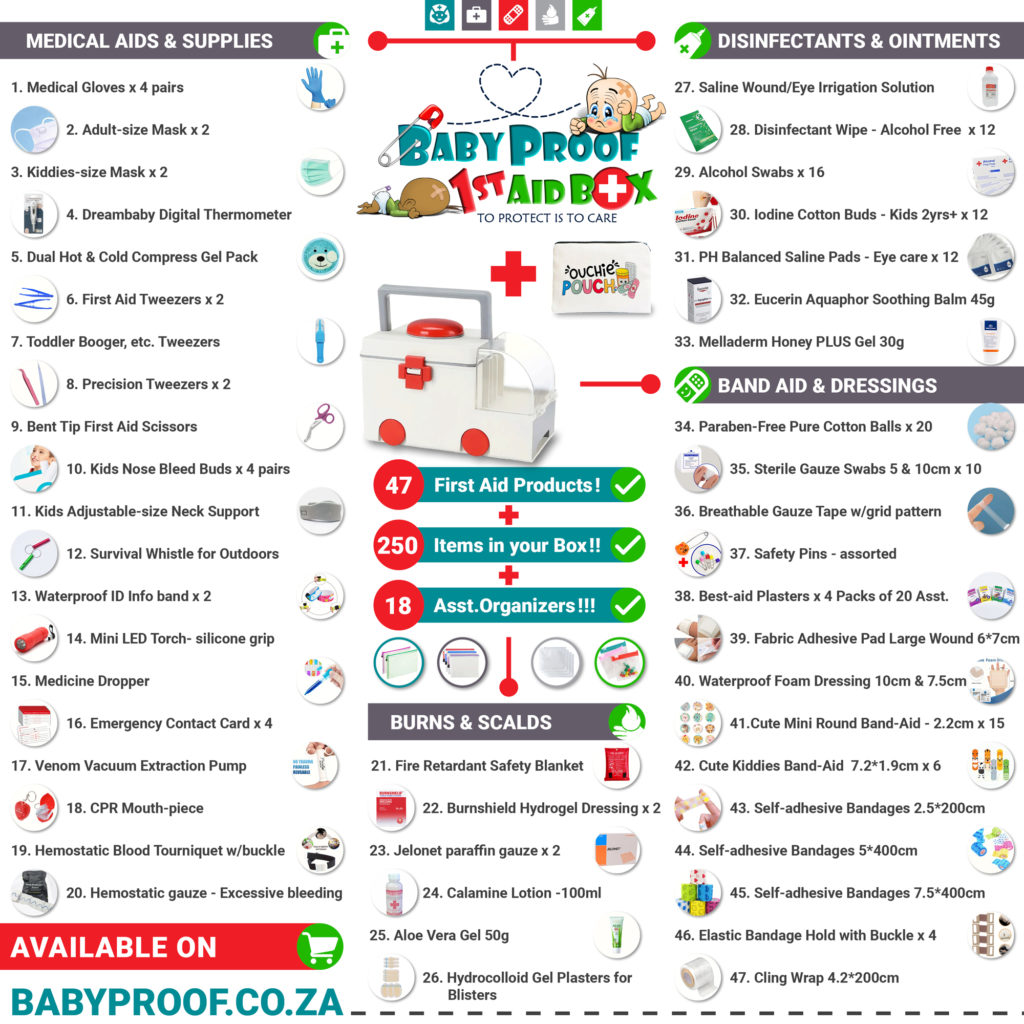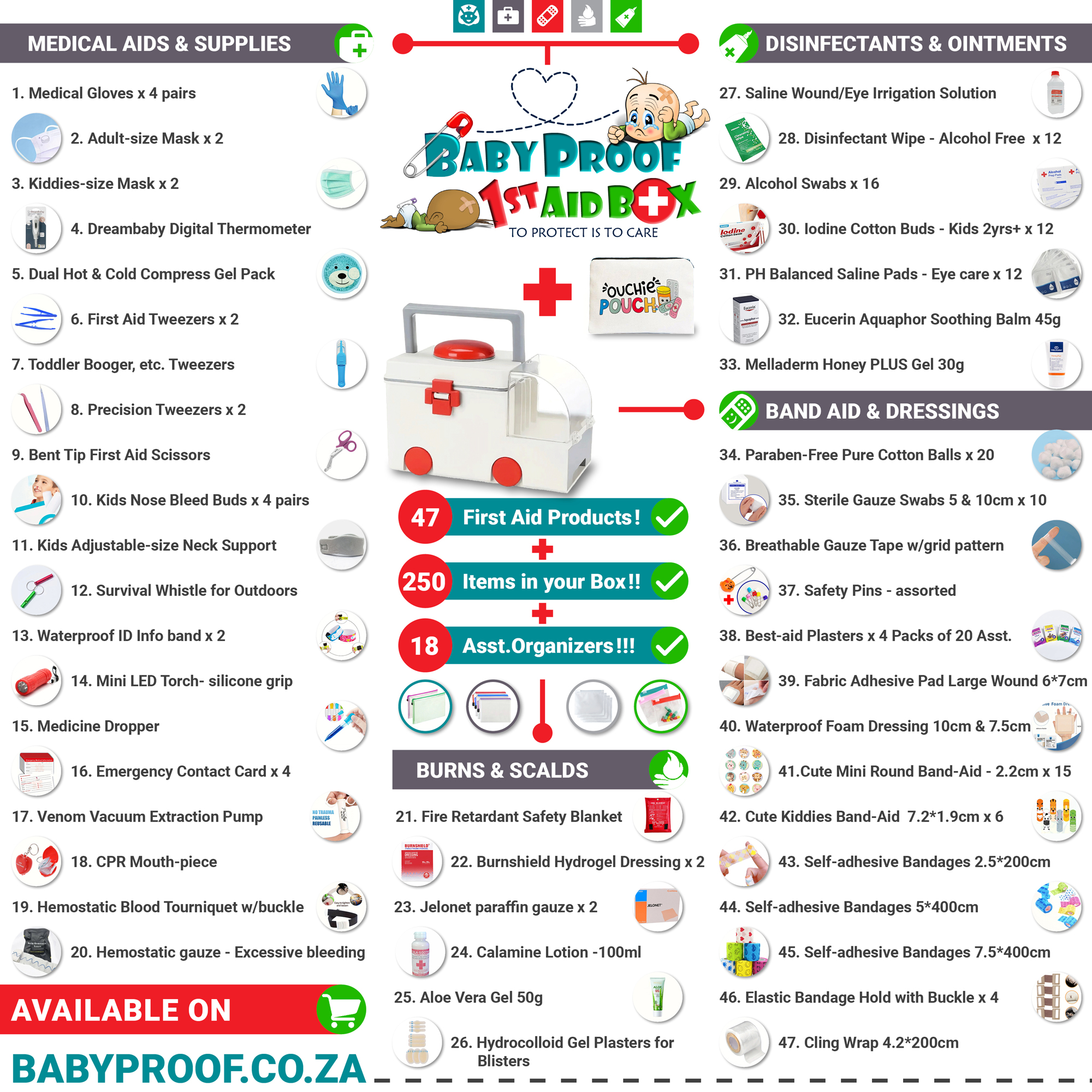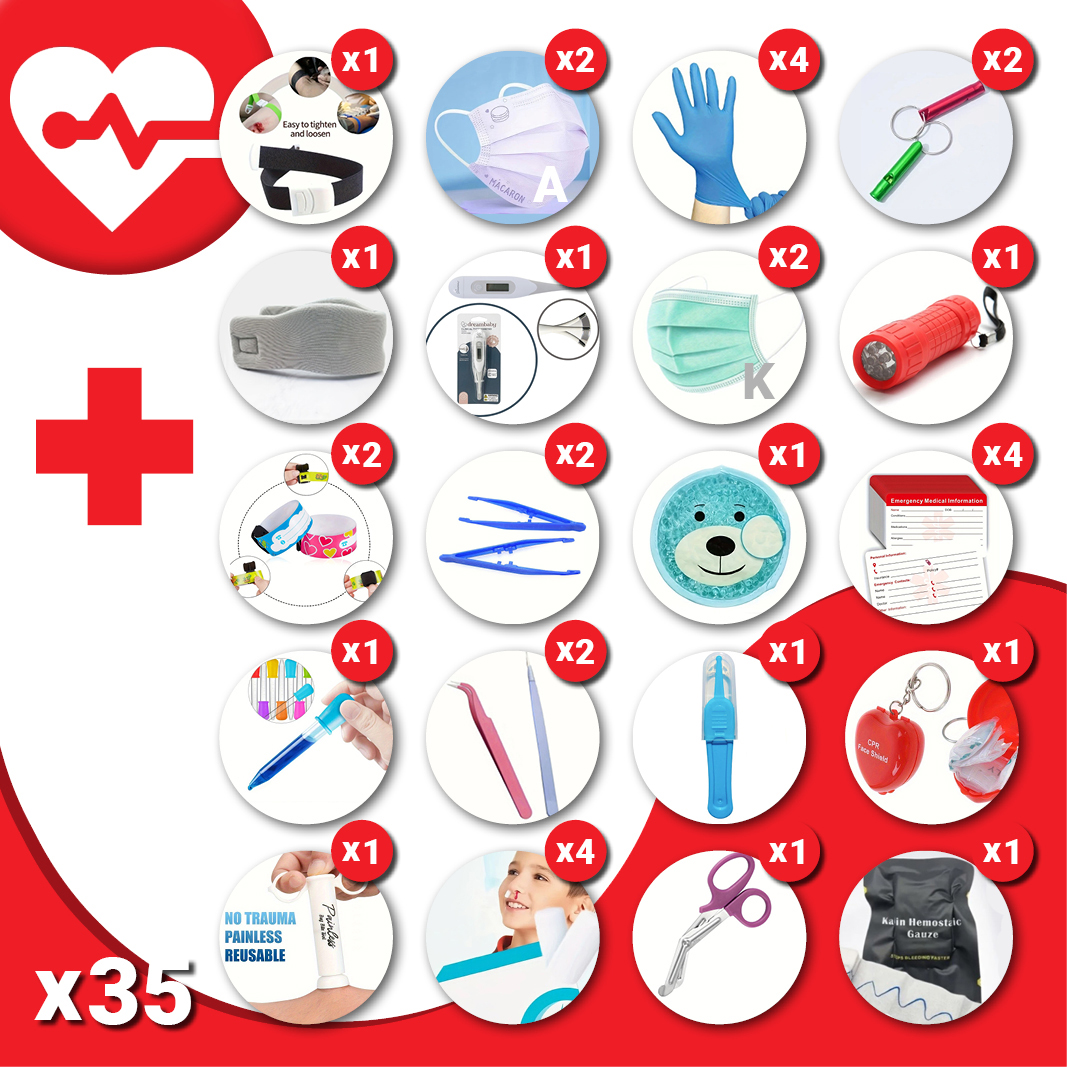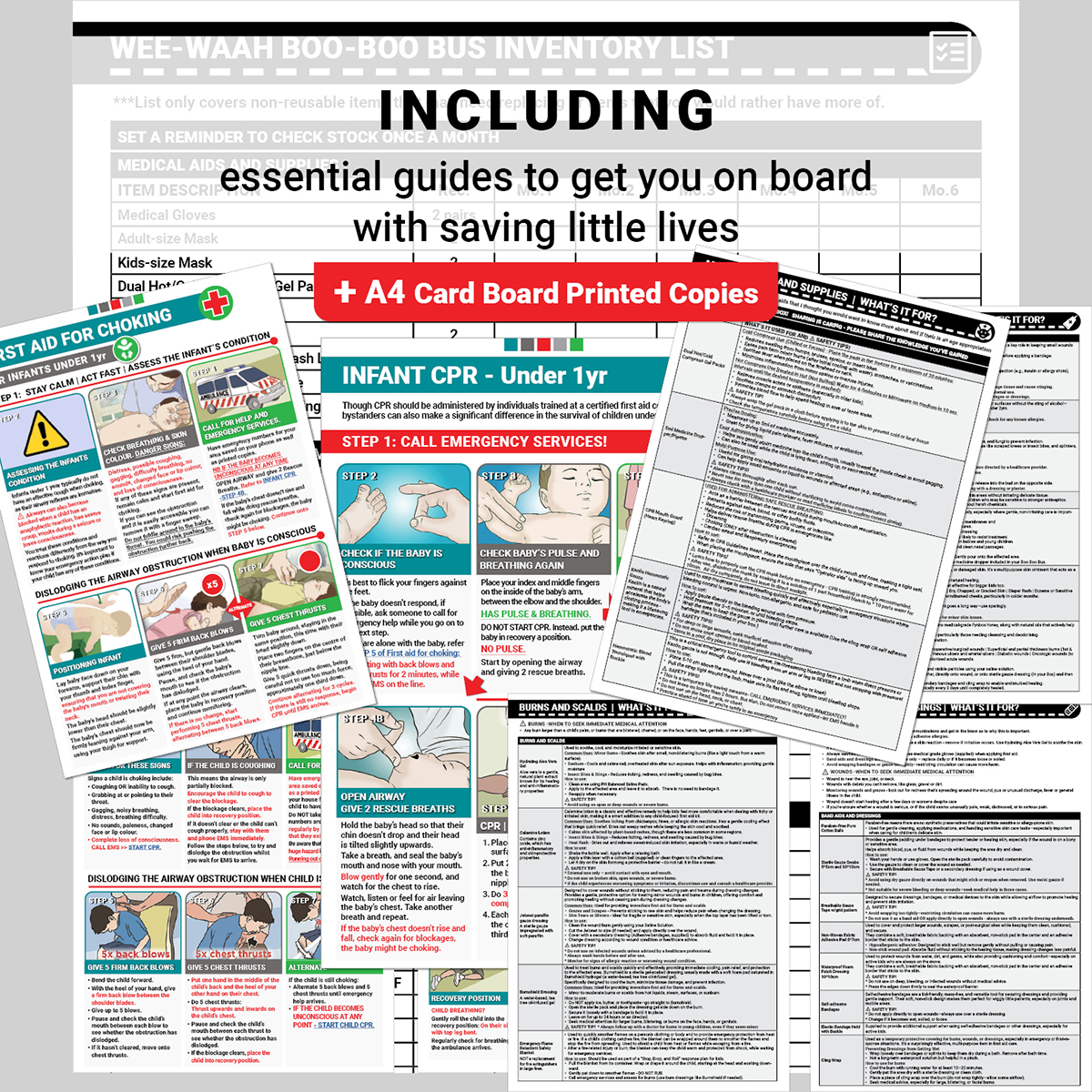Your Comprehensive Guide to Assembling a Family First Aid Kit with Essential Supplies and Medications
Preparing your family for unforeseen circumstances begins with a carefully assembled collection of necessary supplies and medications. A well-organized first aid kit filled with essential medical supplies can be instrumental in effectively responding to health challenges, especially in the diverse and sometimes unpredictable environments of South Africa. By understanding and acquiring vital medications and supplies for your family first aid kit, you can swiftly address common health concerns and protect your family’s well-being in various scenarios.
Essential Wound Care Supplies to Safeguard Your Family
Effectively managing injuries requires a diverse range of wound care supplies in your family first aid kit. The various environments in South Africa—spanning urban landscapes to remote rural areas—present unique challenges that make proper wound care not merely beneficial, but critical for health and recovery. Having the right supplies on hand ensures that you are prepared to handle injuries promptly and effectively.
Understanding the Importance of Sterile Dressings for Wound Care
A comprehensive first aid kit must contain a stockpile of sterile dressings, which play a crucial role in covering wounds and preventing infections. This aspect is especially vital in South Africa's outdoor settings where individuals often partake in activities that expose them to potential injuries, such as hiking or sports. The availability of sterile dressings in various sizes and shapes caters to different types of wounds, from small cuts to larger abrasions.
For families who love outdoor adventures in picturesque regions like the Cederberg Mountains, the likelihood of minor cuts and scrapes increases. Maintaining a sufficient supply of sterile dressings allows for immediate treatment, significantly reducing the risk of complications that can arise from untreated injuries. Additionally, it is essential to educate all family members, particularly children, on the proper application of these dressings, stressing the importance of cleanliness during wound care. Regularly checking your dressing supplies to ensure they are not expired and are in good condition is crucial for maintaining their efficacy.
Thorough Cleaning with Antiseptic Wipes Before Dressing Application
Having a consistent supply of antiseptic wipes in your first aid kit is invaluable for cleaning wounds prior to dressing them. These wipes are particularly effective at removing dirt and harmful bacteria, which are critical steps in preventing infections. Given the diverse environments in South Africa—from busy urban centers to secluded bush areas—access to clean water for washing wounds is not always guaranteed, making antiseptic wipes an essential resource.
These wipes prove especially useful during family outings where immediate care is necessary, such as after a fall while hiking or a scrape sustained during sports activities. When selecting antiseptic wipes, prioritize those that contain effective antimicrobial agents, such as alcohol or benzalkonium chloride. Educating family members about the importance of promptly cleaning wounds after an injury can lead to improved recovery outcomes and minimize the likelihood of complications later.
Swift Protection of Minor Injuries with Adhesive Bandages
For minor cuts and blisters, having a variety of adhesive bandages in different sizes is essential, particularly given South Africa’s active lifestyle. Whether your family enjoys hiking, participating in sports, or simply going about their daily routines, these bandages offer immediate protection against further injury. Adhesive bandages are available in assorted sizes, allowing you to address various types of injuries effectively.
A larger bandage may be necessary for a scraped knee after a playground fall, while smaller ones are ideal for cuts on fingers. Having a colorful assortment of bandages can make the experience more enjoyable for children who may be anxious about their injuries. Regularly inspecting your first aid kit is vital to ensure that an adequate supply of bandages in good condition is available—nobody wants to deal with a bandage that won’t stick when it’s urgently needed. Teaching family members how to apply bandages correctly can also boost their confidence in managing minor injuries independently.
Key Instruments and Tools for Efficient First Aid Care
A well-stocked family first aid kit should also include essential tools and instruments that facilitate effective care during emergencies. These items significantly enhance your capacity to respond quickly and appropriately to injuries and health issues, providing critical support when it matters most.
Why Scissors are an Indispensable Tool in First Aid Management
Though often overlooked, scissors are an essential tool in any first aid kit. They are invaluable for cutting dressings, clothing, or even seatbelts during emergencies. In South Africa, where outdoor adventures and road trips are frequent, having a sturdy pair of scissors can be lifesaving in critical situations. Opt for scissors with a blunt tip for enhanced safety, particularly if children are part of the family unit. Ideally, scissors should be crafted from stainless steel to prevent rust and maintain hygiene.
Regular inspections are necessary to ensure the scissors are sharp and functional, as dull scissors can hinder effective care. In scenarios where bandages need to be cut to size or clothing must be removed to assess an injury, having functional scissors readily available enables quicker responses. Ensure that family members understand the importance of using scissors safely and how to store them properly after use.
The Essential Role of Tweezers in Injury Management
Tweezers are another critical instrument for any first aid kit. Whether it’s removing splinters from fingers after a day of outdoor play or extracting ticks following a hike in wooded areas, a reliable pair of tweezers is essential for effective care. Choose tweezers with a fine tip for precision and ease of use, and opt for stainless steel tweezers to ensure durability and hygiene.
It is crucial to educate family members on the correct usage of tweezers, especially for removing splinters or ticks. It is equally important to instruct them on the necessity of cleaning the tweezers after each use to prevent infections. In South Africa’s natural environments, where exposure to ticks is prevalent, having tweezers readily available is critical for preventing tick-borne diseases. Including these tools in your first aid kit empowers your family to manage injuries effectively and safely.
Monitoring Health with a Reliable Thermometer
Monitoring temperature is a vital aspect of health management, making a thermometer an indispensable addition to your first aid kit. Given the diverse climatic conditions in South Africa, a reliable thermometer can assist in identifying if someone is developing a fever, which could signal an underlying health issue. Digital thermometers are user-friendly and provide quick results, making them particularly suitable for families, especially those with children.
Some models come equipped with additional features, such as memory storage for tracking temperature trends over time, which can be beneficial when monitoring illnesses. Teach family members how to use the thermometer correctly, including the differences between oral, rectal, and axillary readings. Regular monitoring can help identify health issues early, allowing for timely intervention and care.
Being Prepared with Critical Emergency Items
Being adequately prepared for emergencies necessitates having a selection of emergency items that can provide immediate assistance or support during critical situations. These items can greatly influence safety and well-being for your family during unexpected events.
The Value of an Emergency Blanket for Vital Warmth
An emergency blanket is a compact yet essential item to include in your family first aid kit. These lightweight, reflective blankets are designed to retain body heat, making them indispensable for warmth during unforeseen emergencies, particularly in the cooler regions of South Africa. Emergency blankets are particularly beneficial for families who enjoy outdoor activities such as camping or hiking.
Sudden weather changes can occur, especially in mountainous areas like the Drakensberg, and being equipped with an emergency blanket can provide warmth and comfort until help arrives. Additionally, these blankets can serve multiple purposes, such as offering shelter from rain or sun. Teaching your family about the versatility of emergency blankets can empower them to think critically about their needs in various scenarios.
Whistles: A Small Yet Powerful Tool for Emergency Situations
A whistle may seem like a minor item, but its significance in emergencies cannot be overstated. It serves as an effective tool for calling for help, especially in remote areas of South Africa where cell phone reception may be unreliable. When hiking or engaging in outdoor activities, ensuring that each family member has a whistle can enhance communication during emergencies.
The sound of a whistle travels further than shouting, making it a vital tool for attracting attention if someone gets lost or injured. Encourage family members to practice using the whistle so they feel comfortable with it during a real emergency. It’s also advisable to attach the whistle to specific gear items, such as backpacks, ensuring it is always accessible when needed.
Importance of a Reliable Flashlight for Emergency Preparedness
A dependable flashlight is another essential item for your first aid kit, particularly in South Africa, where power outages can frequently occur. Emergencies can arise at any time, and having a flashlight ensures visibility during nighttime incidents or unexpected power failures. Choose a flashlight that is compact and lightweight for easy transport during outings. LED flashlights are preferable due to their long battery life and brightness.
Regularly check the batteries and replace them as necessary to prevent your flashlight from becoming unusable during critical moments. In emergencies, educate your family on how to use a flashlight effectively, including signaling for help if necessary. Having this tool readily available can provide peace of mind, knowing your family is prepared for unexpected situations.
Core Components of a Comprehensive First Aid Kit
At the heart of your family first aid kit is a comprehensive first aid kit itself. This kit should contain essential supplies for treating minor injuries and ailments, providing immediate care across a variety of situations. Look for a first aid kit that includes items like bandages, antiseptic wipes, gauze, and any specific medications your family might need.
It’s crucial to tailor the kit to your family’s lifestyle and activities. For instance, if you often go camping, you might want to add additional supplies such as insect repellent and burn cream. Regularly reviewing the contents of your first aid kit ensures that everything is in good condition and that expired items are promptly replaced. Involving the family in this process can also serve as an educational opportunity, teaching everyone about the significance of first aid preparedness.
The Role of Protective Gear in Your First Aid Kit
Protecting your family goes beyond merely managing injuries; it also involves having the appropriate protective gear in your first aid kit. This gear minimizes the risk of injury and adds an extra layer of safety in various situations.
Disposable Gloves for Infection Control
Including a pair of disposable gloves in your first aid kit is vital for safeguarding against infection when providing first aid. Gloves act as a barrier between you and bodily fluids, ensuring safety during emergencies. Select medical-grade disposable gloves that are easy to put on and remove. Educate your family about the importance of using gloves when handling wounds or bodily fluids to prevent contamination.
It’s essential to have gloves available for each family member to empower them to assist during emergencies. Regularly check the expiry date on your gloves, as they can deteriorate over time. Storing them in a cool, dry place will help maintain their quality and effectiveness.
Face Masks for Respiratory Protection
Face masks are crucial for respiratory protection, particularly during flu seasons or in crowded spaces where infections can easily spread. Including a few disposable face masks in your first aid kit can significantly impact minimizing illness transmission within your family. The importance of face masks has been underscored in recent years due to global health events.
Educating family members about the correct usage of face masks, including when to wear them and how to dispose of them responsibly, can enhance overall health and safety. Regularly replenishing your supply of face masks and ensuring they are stored in a clean, accessible location within your first aid kit can provide peace of mind during flu seasons or health outbreaks.
Eye Protection: Essential for Safety During Activities
In South Africa, where outdoor activities are prevalent, having a pair of eye protection glasses in your first aid kit can provide critical safety during numerous tasks, from gardening to DIY projects. Invest in safety goggles that offer adequate coverage and protection against debris or chemicals. Educate your family about the importance of wearing eye protection while engaging in activities that could jeopardize their eyesight, ensuring they understand the risks involved.
Regularly inspect your eye protection gear for scratches or damage, as compromised vision can pose additional risks. Encourage family members to develop a habit of wearing eye protection whenever engaging in potentially hazardous activities.
Effective Pain Management Solutions for Family Comfort
Pain relievers are a vital component in alleviating discomfort stemming from various ailments, which can include everything from headaches to muscle strains. In South Africa’s variable climate, having dependable medications like paracetamol and ibuprofen readily available is crucial. These medications not only provide effective relief from pain but also help reduce fever, making them essential for family outings, outdoor adventures, or even daily activities.
Paracetamol is frequently recommended for its ability to effectively relieve mild to moderate pain, such as headaches or feverish symptoms. It is generally safe for most individuals, including children, when used according to the recommended dosages. Conversely, ibuprofen, a type of nonsteroidal anti-inflammatory drug (NSAID), not only alleviates pain but also combats inflammation, making it particularly useful for treating injuries like sprains or strains—common occurrences during outdoor activities such as hiking in the Drakensberg or exploring the scenic Garden Route.
Being aware of regional health trends is essential. In urban areas where pollution may exacerbate respiratory problems, having pain relievers on hand can assist in managing sudden headaches or migraines triggered by environmental stressors. Additionally, regularly checking the expiry dates of medications and ensuring proper storage away from sunlight and moisture is vital for maintaining the effectiveness of your medications.
Essential Anti-Diarrhoeal Medications for Family Health Management
In South Africa, gastrointestinal issues can arise from various factors, particularly in rural regions where water quality may be questionable. Including loperamide in your family first aid kit is indispensable for managing sudden episodes of diarrhea, which can lead to dehydration if not addressed promptly. Loperamide works by slowing intestinal movement, thereby decreasing the frequency of stools. This is especially crucial in outdoor environments where access to clean restrooms may be limited.
When embarking on hikes or camping trips in picturesque locations like the Blyde River Canyon, it’s wise to carry this medication along with oral rehydration solutions to effectively mitigate the risks of dehydration. In addition to having loperamide on hand, educating your family about good hygiene practices can help prevent gastrointestinal issues. This includes washing hands before meals, drinking only bottled or treated water, and consuming well-cooked food, particularly when dining in local markets or restaurants.
Allergy Management with Effective Antihistamines
Allergic reactions can vary from mild irritations to severe responses, especially during pollen-heavy seasons in South Africa. Having a reliable supply of antihistamines is crucial for managing allergies triggered by pollen, dust, or insect bites. Products like cetirizine or loratadine are effective at alleviating allergy symptoms, providing relief from sneezing, itching, or hives. For families engaging in outdoor activities, these medications can prove invaluable.
Whether enjoying a picnic at the Kirstenbosch National Botanical Garden or spending a day at the beach in Durban, being prepared with antihistamines is crucial for effectively managing allergies. Antihistamines can also be instrumental in addressing reactions to insect stings or bites, which are common in rural and suburban settings, especially during warmer months. It is important to keep in mind that some antihistamines may cause drowsiness; therefore, always read the labels and ensure responsible usage, particularly when engaging in activities that require alertness.
Understanding the Role of Antibiotics in Family Healthcare
In densely populated areas across South Africa, bacterial infections can pose significant health risks. Including a supply of amoxicillin in your family first aid kit can be invaluable for addressing common infections, including ear and throat infections. While antibiotics are generally not available over the counter, consulting with a healthcare professional is essential for obtaining a prescription for family members in need of this medication.
Recognizing when antibiotics are necessary can help avert complications and ensure timely treatment. Educating your family about the importance of completing the full course of antibiotics, even if symptoms improve, is vital to combat antibiotic resistance effectively. Additionally, fostering good hygiene practices can help minimize the spread of infections, particularly during school seasons or in crowded public areas.
Malaria Prevention with Antimalarials for Travel Safety
In specific regions of South Africa, especially Limpopo and KwaZulu-Natal, there is a heightened incidence of malaria. For families traveling to these areas, including malarone or other antimalarials in your first aid kit is crucial for both the prevention and treatment of this disease. Before embarking on travel, it’s wise to consult with a healthcare professional regarding the need for malaria prophylaxis.
Understanding the symptoms associated with malaria—such as fever, chills, and flu-like signs—can significantly aid in early detection and prompt treatment, potentially making the difference between recovery and severe health complications. Education on mosquito prevention strategies, such as using insect repellent, sleeping under mosquito nets, and wearing long sleeves, should accompany the medication. Being prepared enables your family to enjoy your adventures in malaria-prone regions without unnecessary concern.
Prioritizing Hydration and Nutrition for Family Well-being
Ensuring proper hydration and nutrition is vital for overall health, particularly during emergencies. Including hydration and nutritional supplies in your family first aid kit can play a significant role in ensuring your family remains healthy and energetic.
The Significance of Oral Rehydration Salts for Hydration
In a country like South Africa, where heat can lead to dehydration, having oral rehydration salts in your first aid kit is crucial. These salts help replenish lost fluids and electrolytes, particularly after episodes of diarrhea or excessive perspiration. Oral rehydration salts are user-friendly—simply mix them with clean water according to the instructions provided. Educating your family on the importance of rehydration, especially during hot weather or following physical exertion, can help prevent dehydration-related complications.
Additionally, teaching family members to recognize the signs of dehydration—such as increased thirst, dry mouth, and reduced urine output—can empower them to take proactive steps to hydrate effectively.
Quick Nutritional Support with Energy Bars
During emergencies, energy levels can deplete rapidly. Stocking your first aid kit with energy bars provides a quick source of nutrition during stressful situations, making them an excellent addition for outdoor adventures or extended trips. Select energy bars that are nutrient-dense, providing a balanced mix of carbohydrates, proteins, and healthy fats. Popular choices include those made with oats, nuts, and dried fruits. Familiarize your family with the different types available and encourage them to carry a bar during outings.
Discussing the importance of maintaining energy levels during outdoor activities, such as hikes in Table Mountain National Park, can help your family understand when to consume these snacks and how they can support overall performance and well-being.
Bottled Water: Essential for Maintaining Hydration
Staying hydrated is a necessity, making bottled water a must-have in your family first aid kit. In South Africa’s arid regions, having a reliable source of clean drinking water can significantly impact health, especially during emergencies. Invest in BPA-free bottles that can be reused and filled with clean water for outings. Educate your family on the importance of drinking water regularly, particularly on hot days or while engaging in physical activities.
Regularly check your supplies of bottled water and replace them as necessary to ensure quality. Teaching family members about the significance of hydration in maintaining health can reinforce positive habits and encourage proactive behavior.
Balanced Hydration with Electrolyte Drinks
Including electrolyte drinks in your first aid kit can help maintain hydration and electrolyte balance, especially during hot weather or after prolonged physical activity. These drinks replenish essential minerals lost through sweat. Choose electrolyte drinks that are free from added sugars for a healthier option. Encourage family members to consume these beverages during long hikes, sporting events, or hot days at the beach to stave off dehydration.
Educating your family on recognizing the symptoms of electrolyte imbalance, such as muscle cramps or fatigue, can promote timely hydration strategies and enhance overall well-being during active outings.
Addressing Local Health Challenges in South Africa
Given South Africa’s unique environment and health challenges, certain items in your first aid kit should be tailored to the local context. Ensuring your family is prepared for specific health risks can enhance safety during outdoor activities and travel.
The Importance of a Snake Bite Kit for Emergency Preparedness
In South Africa, encountering snakes in the wild is a reality, particularly in rural and bush areas. Including a snake bite kit in your family first aid kit is vital for effectively handling potential snake bites. A snake bite kit typically includes a pressure bandage and instructions for its use. Educating your family members about snake identification and safety measures can help prevent dangerous encounters.
Understanding the correct first aid response to a snake bite can save lives. In the event of a snake bite, remain calm, keep the affected limb still, and seek immediate medical attention while applying a pressure bandage above the bite to slow the spread of venom. Regularly inspect your kit to ensure that the snake bite kit is complete and in good condition.
Protecting Against Harmful Sun Exposure with Sunscreen
With South Africa’s intense sun exposure, having a high-SPF sunscreen in your first aid kit is crucial for protecting skin against harmful UV rays. Sunburn can occur swiftly, leading to discomfort and an increased risk of skin-related issues. Select a broad-spectrum sunscreen that offers protection against both UVA and UVB rays. Teach your family about the importance of applying sunscreen generously and reapplying it every few hours, especially during prolonged outdoor activities like hiking in the Karoo.
Regularly check the expiry date of your sunscreen, as expired products can lose their effectiveness. Encouraging daily sunscreen application can foster lifelong skin protection habits within your family.
Preventing Insect Bites and Diseases with Effective Repellent
Preventing bites from mosquitoes and other insects is crucial in South Africa, particularly in areas prone to diseases like malaria and dengue fever. Including a reliable insect repellent in your first aid kit can help safeguard your family from these threats. Opt for repellents containing DEET or picaridin for effective protection. Educate your family on the proper application of repellent, ensuring that all exposed skin is covered and that it is reapplied as necessary, particularly after swimming or sweating.
Understanding the best practices for avoiding insect bites—such as wearing long sleeves and steering clear of scented products—can enhance your family’s protection during outdoor adventures.
Malaria Prophylaxis for High-Risk Areas in South Africa
For families traveling to malaria-endemic regions in South Africa, including a supply of malaria prophylaxis in your first aid kit is essential. This medication plays a crucial role in preventing malaria, a severe disease transmitted by mosquitoes. Consult with a healthcare professional before traveling to determine the appropriate prophylactic medication and dosage. Educating your family about malaria symptoms—such as fever, chills, and flu-like signs—can facilitate early detection and treatment.
Incorporate additional malaria prevention measures, such as using insect repellent and sleeping under treated mosquito nets. Awareness and preparedness can significantly reduce the malaria risk during your family’s adventures.
Documentation and Communication for Enhanced Emergency Preparedness
Ensuring that the right documentation and communication tools are accessible within your first aid kit can greatly enhance your preparedness for emergencies. These items ensure that you are informed and ready to act swiftly.
Baby Proof’s First Aid Kits include ESSENTIAL GUIDES to equip you with the knowledge to save little lives!
Your First Aid Manual: A Guide to Emergency Procedures
A well-compiled first aid manual should be a staple in your family first aid kit. This manual serves as an invaluable guide for emergency procedures, covering a wide range of potential scenarios that your family may encounter. Having a manual allows family members to refer to it when uncertainty arises, providing reassurance and clarity during critical situations.
Choose a manual tailored to South African contexts, incorporating common local injuries and ailments to enhance its relevance and utility. Encourage family members to familiarize themselves with the manual’s content, ensuring they know how to access crucial information quickly. Regularly reviewing and updating your manual to reflect new guidelines or practices reinforces the importance of ongoing first aid education.
Effective Communication Tools for Emergency Readiness
In emergencies, having reliable communication tools is imperative. Including items like a portable phone charger, a pre-written list of emergency contacts, and a whistle can enhance your family’s ability to reach out for help. Encourage family members to store emergency contact information in their phones and also keep a paper copy in your first aid kit. This ensures they can access it quickly when needed. Regularly review and update this information to keep it current and relevant.
Understanding the importance of communication during emergencies can empower your family to act quickly. Practicing emergency scenarios together can enhance preparedness, ensuring everyone knows how to respond effectively.
Frequently Asked Questions about Family First Aid Kits
What essential items should be included in a family first aid kit?
A well-stocked family first aid kit should encompass vital medications, wound care supplies, tools, emergency items, protective gear, hydration and nutrition supplies, and specific items tailored to your region’s needs.
How often should I check my first aid kit?
It is advisable to check your first aid kit every three to six months to ensure all items remain in good condition and to replace any expired medications or supplies.
Are pain relievers safe for children?
Yes, pain relievers such as paracetamol can be safe for children when administered in appropriate doses. Always consult a healthcare professional for guidance on dosage based on age and weight.
What should I do if someone gets bitten by a snake?
Remain calm, keep the affected limb still, and seek immediate medical attention while applying a pressure bandage above the bite to slow the spread of venom.
How can I prevent dehydration during outdoor activities?
Carry water and oral rehydration salts in your first aid kit, and encourage regular drinking, especially during hot weather or after physical activity.
What insect repellent is most effective in South Africa?
Choose insect repellents containing DEET or picaridin for effective protection against mosquitoes and other insects commonly found in South Africa.
How do I properly clean a wound?
Use antiseptic wipes to clean around the wound, remove any debris, apply an antiseptic solution, and cover it with a sterile dressing to prevent infection.
Is it necessary to have a first aid manual in my kit?
Yes, a first aid manual can be invaluable for understanding emergency procedures, ensuring family members know how to respond effectively during a crisis.
What is the importance of having sunscreen in a first aid kit?
Sunscreen is crucial for protecting skin from harmful UV rays, preventing sunburn, and reducing the risk of skin-related issues during outdoor activities.
How can I prepare my family for emergencies?
Educate your family on first aid procedures, ensure everyone knows how to access supplies, and practice emergency scenarios to enhance preparedness.
Check out our vibes on Instagram!
The article What to Include in a Well-Stocked Family First Aid Kit was published first on: https://www.babyproof.co.za
The Article Essential Items for a Well-Stocked Family First Aid Kit Was Found On https://limitsofstrategy.com





